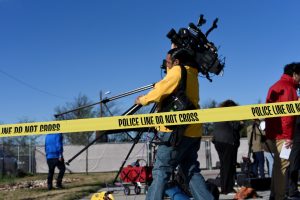By Jon Herskovitz and Jim Forsyth
AUSTIN/SCHERTZ, Texas (Reuters) – A package bomb blew up at a FedEx distribution center near San Antonio on Tuesday, the fifth in a series of attacks that have rocked Texas this month and sent investigators on a frantic search for what they suspect is a serial bomber.
The package filled with nails and metal shrapnel was mailed from Austin to another address in Austin and passed through a sorting center in Schertz, about 65 miles (105 km) away, when it exploded on a conveyer belt, knocking a female employee off her feet, officials said.
It was the fifth explosion in Texas in the past 18 days and the first involving a commercial parcel service.
“We do believe that these incidents are all related. That is because of the specific contents of these devices,” interim Austin Police Chief Brian Manley told members of the Austin City Council, the Austin American-Statesman reported.
A second package sent by the same person was discovered and turned over to law enforcement, FedEx Corp said in a statement. Meanwhile police had surrounded yet another FedEx location in the Austin area after discovering a suspicious package there.
The series of bombings have unsettled Austin, the state capital of some 1 million people, and drawn hundreds of federal law enforcement investigators to join local police. Schertz lies on the highway between Austin and San Antonio.
Speaking through the media, officials have appealed to the bomber to reveal the motives for the attacks. They have also asked the public for any tips, offering a $115,000 reward for information leading to the arrest and conviction of the culprit.
White House spokeswoman Sarah Sanders said in a tweet: “We are committed to bringing perpetrators of these heinous acts to justice. There is no apparent nexus to terrorism at this time.”
The White House did not respond to a request for comment on whether it was ruling out both international and domestic terrorism.
“This is obviously a very, very sick individual, or maybe individuals,” President Donald Trump told reporters. “Theseare sick people, and we will get to the bottom of it.”
Investigators were trying to come up with a theory or intelligence regarding the motive for the bombings or identity of the bomber or bombers, a U.S. security official and a law enforcement official told Reuters.

Members of the media move cameras around before the start of a news conference outside the scene of a blast at a FedEx facility in Schertz, Texas, U.S., March 20, 2018. REUTERS/Sergio Flores
The Federal Bureau of Investigation was investigating the FedEx package explosion as if there were a connection to the Austin bombings, the law enforcement official said. Both sources declined to be identified.
The individual or people behind the bombings are likely to be highly skilled and methodical, said Fred Burton, chief security officer for Stratfor, a private intelligence and security consulting firm based in Austin.
“This is a race against time to find him before he bombs again,” Burton said.
The four previous explosions killed two people and injured four others.
The first three devices were parcel bombs dropped off in front of homes on in three eastern Austin neighborhoods. The fourth went off on Sunday night on the west side of the city and was described by police as a more sophisticated device detonated through a trip wire.
The four devices were similar in construction, suggesting they were the work of the same bomb maker, officials said.
Federal authorities at the scene of Tuesday’s blast offered few details, telling reporters their probe was in the early stages and that the building would be secured before investigators could gather evidence.
The FBI and the Bureau of Alcohol, Tobacco, Firearms and Explosives (ATF) were among those working with local officials in Austin, Schertz and San Antonio.
“We have agents from across the country. We have our national response team here. We have explosive detection canines here. We have intel research specialists,” Frank Ortega, acting assistant special agent in charge of the San Antonio ATF office, told reporters. “We’ve been working around the clock.”
(Additional reporting by Brendan O’Brien in Milwaukee and Mark Hosenball and Lisa Lambert in Washington; Writing Daniel Trotta; Editing by Jeffrey Benkoe and Tom Brown)
 A FedEx truck is seen outside FedEx facility following the blast, in Schertz, Texas, U.S., March 20, 2018. REUTERS/Sergio Flores
A FedEx truck is seen outside FedEx facility following the blast, in Schertz, Texas, U.S., March 20, 2018. REUTERS/Sergio Flores
